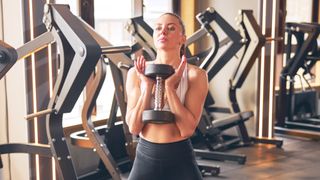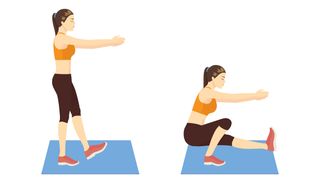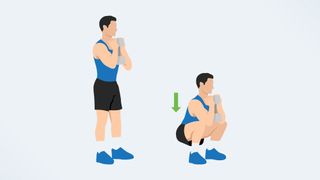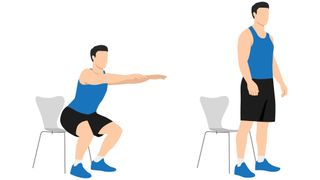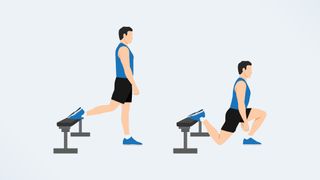Pistol squats are one of the most dreaded daily leg exercises because you’ll need to balance on one leg to perform them. But the lower-body variation of the squat is worth a try, and we explain why below.
To perform pistol squats, you’ll need to stand on one leg and perform a single-leg squat, without dropping or lifting your heel off the ground. Sounds simple, right? Wrong. It’s an exercise that personal trainers everywhere dread demonstrating during workouts, but the movement has benefits, especially for the runners out there.
Below, we explain how to perform pistol squats with proper form and the most common mistakes we see when we try them. Read on to find out the benefits of pistol squats and why the leg exercise is effective for building strength, power, and balance.
Pistol squats: benefits
The single leg squat is a compound technique exercise that works the body unilaterally, i.e. one side at a time. Your stronger side can’t pick up the slack for you, helping your body even out any muscle imbalances and build strength and mobility in your weaker areas. Ironing out the differences between the dominant and less dominant sides also helps reduce the risk of injury and improve the quality of movement.
Like all great leg exercises, pistol squats help build strength and explosive power because your body relies on one leg to control and execute the movement. Not only will you work your glutes, quads, hip flexors, hamstrings, and calves, but you’ll also improve your hip and ankle flexor range of motion, and build strength and stability in your lower back and core muscles.
For obvious reasons, the pistol squat improves stability, balance, and control, and finding depth in the single-leg squat position helps develop flexibility. And since runners ride one leg at a time, it might help them too. Basically, this exercise is the perfect all-rounder.
Whether or not your goal is to build strength and muscle in your legs, this move should be a staple if you want to develop squat depth: how far you can lower yourself without winking during squats (rounding the bottom of the back). It can help build range of motion in lower-body joints like the hips, knees, and ankles, which results in better lunging form, running technique, and more.
So, just a few benefits to enjoy then.
Can the average person do a pistol squat?
The move requires some squat know-how and an existing degree of strength and flexibility. The pistol squat technique also takes time to develop. We cover three variations below and the common mistakes we see so you can improve your form of pistol squats or learn how to do them from scratch.
How to perform pistol squats
Here is a step by step guide:
- Stand with your feet hip-width apart and your toes pointing forward
- Engage your core and stand up through your spine
- Lift your left leg off the floor and extend it out in front of you, foot flexed
- Extend both arms in front of you at shoulder height
- Bend your right knee and sit in a squat position, lowering yourself to the floor with control
- Squat down as far as possible with right heel planted down and keep your chest lifted and back straight. Keep your left leg and both arms extended forward
- Push off your right foot to stand up. Switch sides.
Pistol squats: 3 common mistakes
You can try the movement anywhere with or without weights, using the best adjustable dumbbells or resistance bands. But here’s what not to do when trying the pistol squat.
It doesn’t heat up
The move is no walk in the park, so prepare your muscles and joints before attempting pistol squats. We recommend these range of motion exercises for hip flexor pain and tight ankles. Fail preparation, prepare to fail, and so on. My favorite is the frog pose for hip flexor pain, which is also good for improving squat depth.
Raise your heels
Keep your feet heel on the ground as you lower yourself, which should help prevent you from shifting your body weight onto your toes and falling over. Avoid lifting up on the ball of your foot just to lower yourself, as doing so will never perfect the movement and risk putting pressure on your knees. Imagine sitting in a chair as you lean down.
Incorrect posture
Another common mistake involves rounding the spine and bending forward. Keep your spine high and neutral, lifting your chest. A slight forward lean is safe, but leaning too far will put more pressure on your spine and knees and prevent you from exhaling properly as you stand up.
The same goes for the knees: push the knee in line with the toes to avoid sagging inward and compromising posture.
Pistol squats: 3 variations and modifications to try
If you need help modifying pistol squats, here are variations to try.
1. Bodyweight squats
Bodyweight squats will help you build the core strength and range of motion needed for pistol squats and activate the relevant muscle groups. We provide everything you need to know about squats here. Once you feel confident, add weight using barbells, dumbbells or resistance bands.
2. Assisted pistol squat
These are the best pistol squats for beginners. Place a chair behind you and practice squatting down (see above). Then, using the practice guide above, practice doing this while balancing on one leg and extending the other out in front of you.
You can practice at different heights to work on your range of motion or place your front heel in front of you for extra support as you sit up.
3. Weighted Bulgarian split squat
The Bulgarian split squat requires placing one leg behind you on a box or bench as you lunge. The move tests balance, stability, flexibility and coordination and works the same muscle groups as a pistol squat. By leaning forward slightly, you can increase glute activation during the exercise, and holding a weight on your chest will make the exercise more difficult.
Split squats also stretch and strengthen the hip flexors and test ankle range of motion at the bottom of the lunge.
How to schedule pistol squats during workouts
It depends on your goals: Let’s discuss hypertrophy versus strength training if you need guidelines for building muscle and strength. However, a good rule of thumb is to start with 2-4 sets of 3-6 reps per side and build from there.
I like to program new exercises like EMOM, every minute by the minute. Using this format, practice a set number of reps on each side and rest for the rest of the minute, starting a new round the next minute. Try to complete several rounds – just five equals five minutes of pistol squat practice!
And remember, practice makes perfect. Some people never achieve pistol squats, but you can improve your chances by trying them regularly and working on range of motion exercises as part of your workout routine.
More from Tom’s Guide
#Pistol #squats #perform #benefits #strengthening #legs #buttocks
Image Source : www.tomsguide.com
